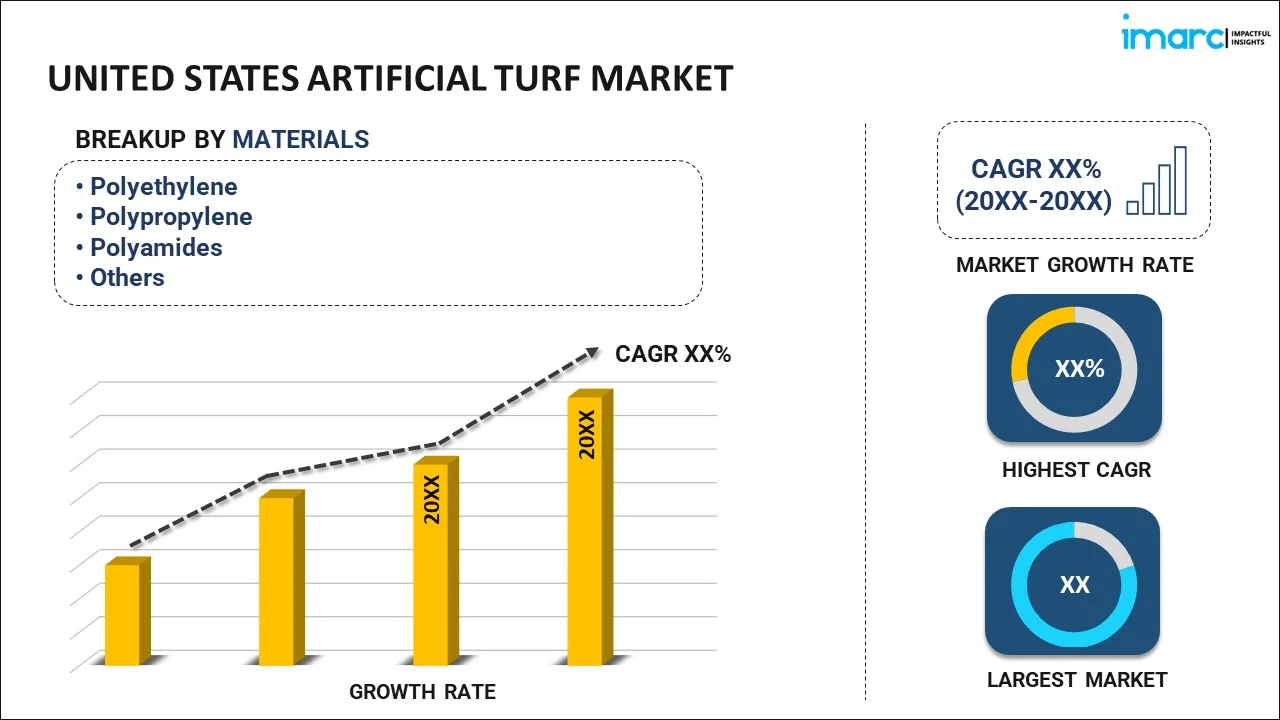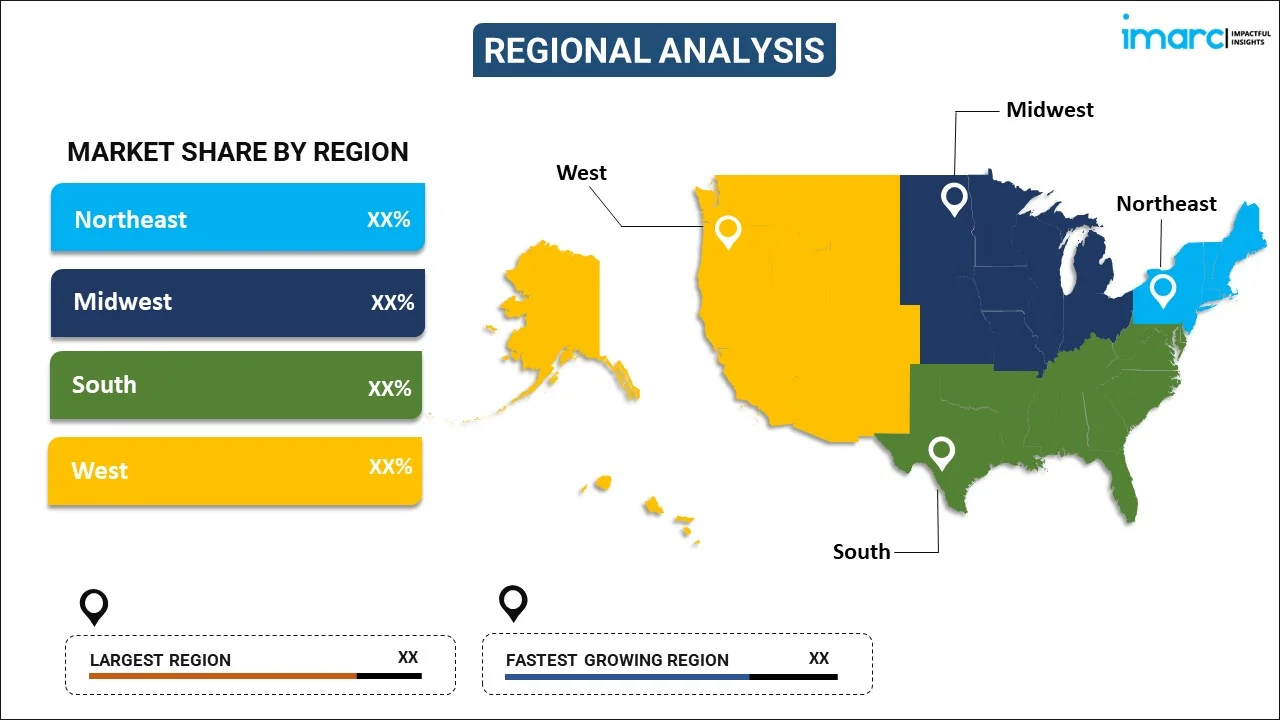
United States Artificial Turf Market Report by Material (Polyethylene, Polypropylene, Polyamides, and Others), Application (Household, Sports and Leisure, Restaurant and Hotels, Airports and Commercial Offices, and Others), Distribution Channel (Direct Sales/B2B, Online Stores, Specialty Stores, Convenience Stores, and Others), and Region 2025-2033
Market Overview:
United States artificial turf market size is projected to exhibit a growth rate (CAGR) of 18.25% during 2025-2033. The increasing popularity of sports such as soccer, football, and tennis that has led to a rising demand for artificial turf in sports facilities, is driving the market.
|
Report Attribute
|
Key Statistics
|
|---|---|
|
Base Year
|
2024 |
|
Forecast Years
|
2025-2033
|
|
Historical Years
|
2019-2024
|
| Market Growth Rate (2025-2033) | 18.25% |
United States Artificial Turf Market Analysis:
- Key Market Drivers: The United States artificial turf industry is propelled by rising demand for low-maintenance landscaping, water savings, and improved aesthetics in residential, business, and sporting uses. Increased urbanization and climate-friendly efforts further boost market adoption across various sectors.
- Key Market Trends: Technological innovations in synthetic grass technology, UV-resistant coatings, and green fibers are influencing the United States artificial turf market trends. Growing demand for sustainable, long-lasting, and realistic turf solutions for sport, landscaping, and recreation continues to drive market growth.
- Competitive Landscape: The United States artificial turf industry is defined by innovation-driven players that develop sophisticated, long-lasting, and eco-friendly products. Players stress strategic partnerships, product tailoring, and performance differentiation to establish strong market standing and capture increased demand in residential, commercial, and sporting segments.
- Challenges and Opportunities: United States artificial turf market challenges are high upfront installation expenses and environmental issues, while opportunities for growth and technology development lie in increasing adoption for sporting facilities, urban areas, and environmentally friendly outdoor solutions, driving growth and technological advancement throughout the industry.
Artificial turf, also known as synthetic grass or fake grass, is a surface made from synthetic fibers designed to mimic the appearance and texture of natural grass. Composed of materials like polyethylene, polypropylene, or nylon, these synthetic fibers are UV-stabilized to withstand sunlight and weather conditions. The turf is typically laid over a base of compacted gravel and sand for stability. Artificial turf offers a low-maintenance alternative to natural grass, as it requires no mowing, watering, or fertilizing. It is resilient and can withstand heavy foot traffic, making it suitable for various applications, including sports fields, playgrounds, and decorative lawns. While artificial turf has environmental considerations, such as limited biodegradability and heat retention, ongoing advancements aim to address these concerns and enhance the sustainability of synthetic grass systems.
United States Artificial Turf Market Trends:
Growing Adoption in Residential Landscaping
Growing adoption of artificial turf in residential landscaping is on the rise as homeowners increasingly look to low-maintenance, long-lasting, and attractive outdoor solutions. Synthetic grass can offer continuous greenery throughout the year without the requirement of mowing, watering, or fertilization, providing a utilitarian solution to natural lawns. Contemporary turf designs incorporate realistic texture, increased durability, and sophisticated backing and drainage systems, allowing for sustained performance in gardens, patios, roof-top terraces, and city residential areas. Urbanization and constricted green space have also fueled the demand for artificial turf, with residents trying to keep visually appealing landscapes without spatial constraints. Environmental landscaping techniques and water conservation measures have also promoted the use of artificial grass. The use of long-lasting, eco-friendly materials guarantees safety for kids and pets while minimizing environmental hazards. Overall, these factors are fueling United States artificial turf market growth, as residential demand for convenient, visually uniform, and low-maintenance landscaping solutions grows.
Growth in Sports and Recreational Sites
Artificial turf is being increasingly used in sports and recreational venues because of its long life, uniform performance, and minimal maintenance needs. Sport facilities for football, soccer, and baseball, as well as multi-sport stadiums, are all enhanced with artificial surfaces that can endure intensive use and diverse weather conditions. Technological innovations in fiber composition, infill material, drainage, and shock absorption have contributed to improved safety, comfort, and longevity of the fields, allowing for consistent conditions for training and professional events. Recreation parks, indoor sports facilities, and community clubs are implementing synthetic turf as they offer high-performance surfaces at low maintenance costs. Artificial turf provides the capability for a facility to host several sports and activities on one surface without any degradation, providing a money-saving, practical substitute for natural grass. These advancements are helping drive United States artificial turf market share, fueled by increasing adoption within professional and community sports facilities.
Use in Commercial and Public Landscaping
Artificial turf is increasingly being used in commercial and public landscaping applications because of its beauty, durability, and low maintenance requirements. Office campuses, shopping centers, city parks, and civic green spaces increasingly prefer synthetic grass to increase visual appeal, lower water usage, and resist heavy use. Artificial turf is especially effective in sites with irregular surfaces, low sunlight exposure, or heavy use, where natural turf might not work. Enhanced turf technology offers natural appearance, safety, and durability, enabling versatile landscaping options for public and business establishments. Sustainability factors such as lower water use and environmental footprint enable broader use in urban planning and green initiatives. As natural grass lawns are displaced by synthetic surfaces, municipalities and business organizations can create aesthetically pleasing, functional, and cost-effective outdoor environments. Such uses are widely reported in United States artificial turf market analysis, describing adoption patterns and tracing the increasing use of artificial turf in public and commercial landscaping settings.
United States Artificial Turf Market Segmentation:
IMARC Group provides an analysis of the key trends in each segment of the market, along with forecasts at the country level for 2025-2033. Our report has categorized the market based on material, application, and distribution channel.
Material Insights:

To get more information on this market, Request Sample
- Polyethylene
- Polypropylene
- Polyamides
- Others
The report has provided a detailed breakup and analysis of the market based on the material. This includes polyethylene, polypropylene, polyamides, and others.
Application Insights:
- Household
- Sports and Leisure
- Restaurant and Hotels
- Airports and Commercial Offices
- Others
A detailed breakup and analysis of the market based on application have also been provided in the report. This includes household, sports and leisure, and restaurant and hotels, airports and commercial offices, and others.
Distribution Channel Insights:
- Direct Sales/B2B
- Online Stores
- Specialty Stores
- Convenience Stores
- Others
The report has provided a detailed breakup and analysis of the market based on the distribution channel. This includes direct sales/B2B, online stores, specialty stores, convenience stores, and others.
Regional Insights:

- Northeast
- Midwest
- South
- West
The report has also provided a comprehensive analysis of all the major regional markets, which include the Northeast, Midwest, South, and West.
Competitive Landscape:
The market research report has also provided a comprehensive analysis of the competitive landscape in the market. Competitive analysis such as market structure, key player positioning, top winning strategies, competitive dashboard, and company evaluation quadrant has been covered in the report. Also, detailed profiles of all major companies have been provided.
Latest News and Developments:
- In July 2025, Cobalt Digital exhibited a broader portfolio of IPMX-compliant ST 2110 solutions at IBC 2025. Cobalt introduced two new SAPPHIRE BBG-2110 mini converters and a new PACIFIC 9992-ENC encoder, offering low-latency IP conversion, signal management flexibility, and transparent integration in SDI, ST 2110, and IPMX workflows.
- In September 2024, Keysight Technologies launched the InfiniiVision HD3 Series, a 14-bit analog-to-digital converter oscilloscope providing four times the resolution and a half-noise floor compared to usual models. With a custom ASIC and deep memory, it speeds design debugging and increases the measurement accuracy across applications.
United States Artificial Turf Market Report Coverage:
| Report Features | Details |
|---|---|
| Base Year of the Analysis | 2024 |
| Historical Period | 2019-2024 |
| Forecast Period | 2025-2033 |
| Units | Million USD |
| Scope of the Report | Exploration of Historical and Forecast Trends, Industry Catalysts and Challenges, Segment-Wise Historical and Predictive Market Assessment:
|
| Materials Covered | Polyethylene, Polypropylene, Polyamides, Others |
| Applications Covered | Household, Sports and Leisure, Restaurant and Hotels, Airports and Commercial Offices, Others |
| Distribution Channels Covered | Direct Sales/B2B, Online Stores, Specialty Stores, Convenience Stores, Others |
| Regions Covered | Northeast, Midwest, South, West |
| Customization Scope | 10% Free Customization |
| Post-Sale Analyst Support | 10-12 Weeks |
| Delivery Format | PDF and Excel through Email (We can also provide the editable version of the report in PPT/Word format on special request) |
Key Questions Answered in This Report:
- How has the United States artificial turf market performed so far and how will it perform in the coming years?
- What has been the impact of COVID-19 on the United States artificial turf market?
- What is the breakup of the United States artificial turf market on the basis of material?
- What is the breakup of the United States artificial turf market on the basis of application?
- What is the breakup of the United States artificial turf market on the basis of distribution channel?
- What are the various stages in the value chain of the United States artificial turf market?
- What are the key driving factors and challenges in the United States artificial turf?
- What is the structure of the United States artificial turf market and who are the key players?
- What is the degree of competition in the United States artificial turf market?
Key Benefits for Stakeholders:
- IMARC’s industry report offers a comprehensive quantitative analysis of various market segments, historical and current market trends, market forecasts, and dynamics of the United States artificial turf market from 2019-2033.
- The research report provides the latest information on the market drivers, challenges, and opportunities in the United States artificial turf market.
- Porter's five forces analysis assist stakeholders in assessing the impact of new entrants, competitive rivalry, supplier power, buyer power, and the threat of substitution. It helps stakeholders to analyze the level of competition within the United States artificial turf industry and its attractiveness.
- Competitive landscape allows stakeholders to understand their competitive environment and provides an insight into the current positions of key players in the market.
Need more help?
- Speak to our experienced analysts for insights on the current market scenarios.
- Include additional segments and countries to customize the report as per your requirement.
- Gain an unparalleled competitive advantage in your domain by understanding how to utilize the report and positively impacting your operations and revenue.
- For further assistance, please connect with our analysts.
 Request Customization
Request Customization
 Speak to an Analyst
Speak to an Analyst
 Request Brochure
Request Brochure
 Inquire Before Buying
Inquire Before Buying




.webp)




.webp)












